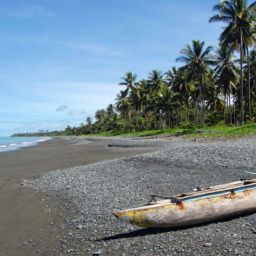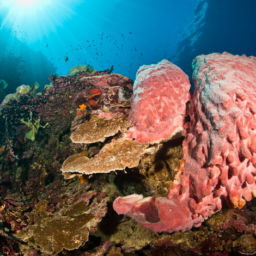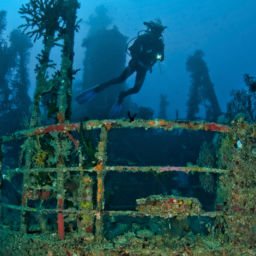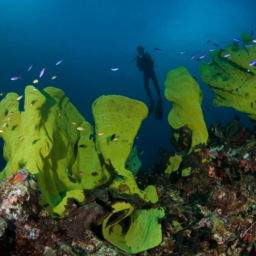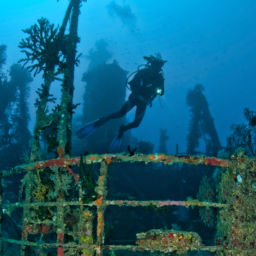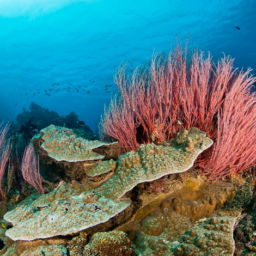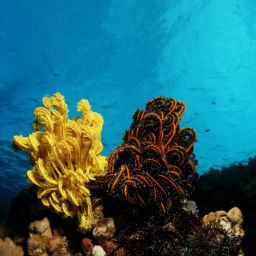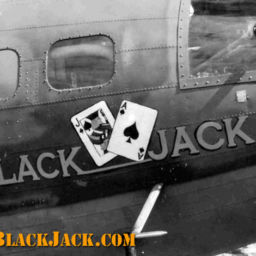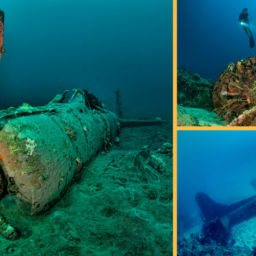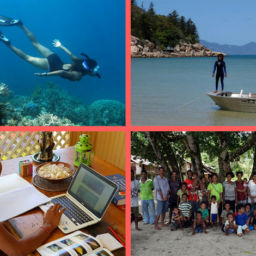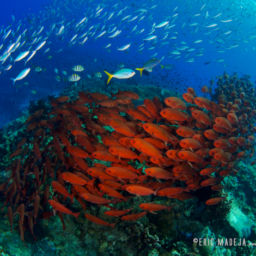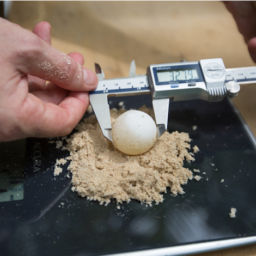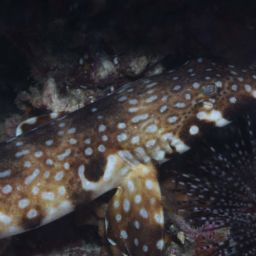Kimbe Bay is to the large island of New Britain what Milne Bay is to Papua New Guinea’s main island of New Guinea: a biodiversity hotspot that offers an incredible variety of diving. Scuba diving in Kimbe Bay also means the chance to visit one of the best-preserved WWII aircraft wrecks in the country.
New Britain is the largest of Papua New Guinea’s 600-plus islands and is part of the huge 19,000-square-mile (50,000 square km) Bismarck Archipelago off the northeastern coast of New Guinea.
Kimbe Bay sits roughly one third of the way along the north coast of New Britain and is world-renowned for its incredible marine biodiversity. Nature Conservancy surveys on 78 sites in the bay have identified 860 species of fish, around 400 species of stony corals and 10 species of whales and dolphins.
To put that in a global perspective: in an area roughly the same size as California, scientists estimate that Papua New Guinea is home to almost 5 percent of the world’s total marine biodiversity. Many birders visit as well because the highland rainforests are as rich in bird life as the waters of the bay are in marine life.
Visually the bay is quite spectacular, with a series of volcanoes dotting its long shoreline. In the bay itself are several dramatic seamounts, rising up from the depths. Those seamounts, combined with numerous excellent reefs and the incredible marine life, are what make scuba diving in Kimbe Bay so special.
How to get to Kimbe Bay
The only real option for getting to Kimbe Bay is by air from Port Moresby to Kimbe, the main town in the area and the provincial capital of West New Britain. Kimbe’s airport is called Hoskins (HKN) and both Air Nuigini and PNG Air serve it regularly. Only Air Nuigini has direct flights.
Logistics in Kimbe Bay
The Papua New Guinea currency is the Kina and $1 USD will buy you about three of them. Most visitors to PNG get whatever Kina they may need at the ATM or currency exchange after arrival at the international airport in Port Moresby. There are a few ATMs available at the banks in Kimbe town, so you can also get cash there if you need to.
Scuba diving in Kimbe Bay
There are two options for diving Kimbe Bay — either land-based using day boats from the resort, or on a liveaboard. Either way you will end up at Walindi Plantation Resort which basically is scuba diving in Kimbe Bay.
Walindi has been operating since 1983, but has come a long way from the single boat and two bungalows that Max and Cecilie Benjamin started with. There are now 12 individual bungalows plus several Plantation Rooms to accommodate visitors, together with a central lodge, restaurant, swimming pool and small bar. The Benjamins’ son Cheyne and his wife Emma took over operations at the resort from Max and Cecilie a few years ago. Walindi operates three day boats, each accommodating six to eight divers, with two dives per day being the norm and a third available on request.
The average time to most dive sites is around 40 minutes, but the more remote sea-mount sites take a bit longer.
Standout dive sites
Generally, the reefs in Kimbe Bay offer excellent diving, but an overall favorite is South Emma’s. The site features a superb assortment of huge barrel sponges, beautiful red sea-whip gorgonians and vibrant soft corals.
To round things off nicely, there’s a deep swim-through cave, and the top of the reef is coated in healthy hard corals. Schooling fusiliers and trevally regularly patrol the area.
Of all the incredible seamounts in Kimbe Bay, Bradford Shoals is the standout attraction. It’s located on the very edge of the bay, with the seafloor some 5,000 feet (1500 m) below. Bradford rises from the abyss to within about 65 feet (20 m) of the surface and its reef structure is mainly flat plates of hard corals. These are home to numerous colorful, small reef fish. But a visit here is not about reef fish — surrounded by deep water and far from the nearest reef structure, Bradford acts as a magnet for big fish and pelagics. There are no guarantees, but you are almost certain to see large schools of barracuda, big-eye trevally, dogtooth tuna, unicorn fish and fusiliers, plus skittish whitetip reef sharks. Gray reef sharks cruise out in the current and hammerheads occasionally visit from the deep.
Dive on a WWII fighter plane
Finally, no visit to Kimbe Bay would be complete without a dive on what is possibly the most intact WWII aircraft wreck in Papua New Guinea. In a small bay, close to South Emma’s reef, is a Japanese Mitsubishi Zero fighter, lying in just 56 feet (17 m) of water.
Research by Max and Cecilie Benjamin based on the aircraft’s serial number established that Tomiharu Honda was the pilot. The plane went missing during the battle of Cape Gloucester on West New Britain on December 26, 1944. The wreck’s location close to shore means that it’s best to dive here when there has been no rain for several days so that the visibility is at its best.
Sitting on the sandy bottom, the plane is covered with a light marine growth and barnacle-like hard-coral growth on the wings and fuselage.
The three blades of the single propeller are still very much intact, covered with sponges and some colorful coral. Fish life is concentrated around the open cockpit.
Liveaboard diving
Walindi’s liveaboard, the MV FeBrina, operates from the resort for about two-thirds of the year and from Rabaul at the eastern tip of New Britain for the rest.
From Walindi, FeBrina covers the remote Witu Islands northwest of Kimbe Bay and Father’s Reef at the eastern edge of the bay. Those outer reefs offer some incredible diving on sites that are rarely if ever dived by other boats.
The highlight of a trip to the exceptional Witu Islands is Garove Island, which is the remains of a huge, sunken volcanic caldera. Diving the black-sand critter site at Wire Bay yields a tremendous assortment of critters and, on any given dive, you may see leaf scorpionfish, hinge-beak shrimp, Steinitz’ shrimp gobies, numerous varieties of clownfish and lots of nudibranchs.
While at Father’s Reef you will encounter what is probably the healthiest population of sharks in PNG. Shaggy’s Reef the highlight of that area because of the dedicated shark feed that FeBrina conducts there.
From Rabaul, the FeBrina covers the remote south coast of New Britain – an area of Papua New Guinea that no other dive boats visit. There are numerous fantastic sites along the south coast, but the standout is West Entrance at Lindenhaven, a small village in the Gasmata area.
As its name suggests, the dive site is on the west entrance to the village. The corals and fish life are prolific and pristine because of the strong, rich currents that course through the entrance. Those currents mean that you can only dive West Entrance around slack tide, but the wait is well worth it.
When to Dive Kimbe Bay
Kimbe Bay’s unique topography protects it from extreme weather, and its dive sites are accessible year-round, although conditions do vary. The best time of year to visit is from September to November, with calm seas and superb visibility typically over 80 feet (25 m) or May through June, which typically features calm seas and clear skies with almost no wind. Water temps vary from around 80 F (27 C) to 88 F (31 C)
Australian Don Silcock is based in Bali. He has dived many of the Indo-Pacific’s best locations. His website offers articles and location guides to the places he has visited and the big animals he has dived with. Learn more about Kimbe Bay and Papua New Guinea in his complete guides.











